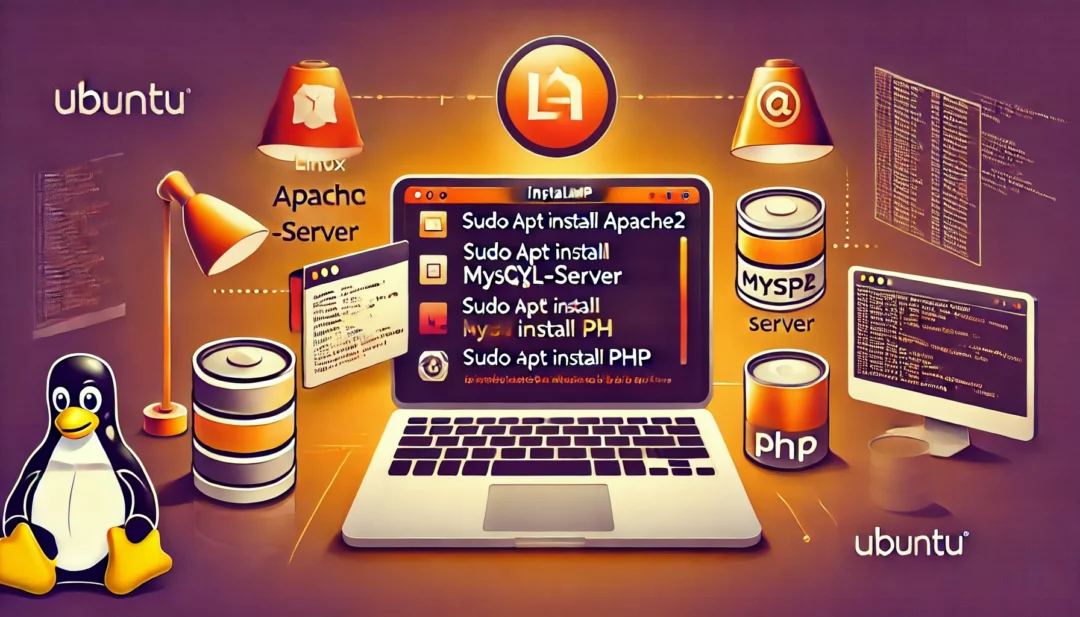
Setting up a LAMP stack on your Ubuntu system is simpler than you might think. LAMP, which stands for Linux, Apache, MySQL, and PHP, is a powerful combination for building and running web applications. Whether you’re preparing a development environment or hosting a live website, installing LAMP is a must-have skill for any Linux user.
You’ll start by updating your system to ensure everything’s up to date. Then, you’ll install Apache to handle web server duties, followed by MySQL for database management. Once that’s done, you’ll add PHP to process dynamic content. Finally, you’ll test the setup to confirm everything’s running smoothly. With just a few commands, your Ubuntu system will be ready to power your projects.
What Is LAMP?
LAMP is an acronym representing a software stack used to host and develop web applications. It comprises Linux, an operating system, Apache, a web server, MySQL, a database management system, and PHP, a scripting language for dynamic content. Together, these components form a robust environment for interactive and dynamic web development.
- Linux: The foundational operating system that provides stability and efficiency for the stack. Ubuntu, as a Linux-based OS, is widely used due to its ease of use and community support.
- Apache: The web server that handles HTTP requests and delivers web pages to user browsers.
- MySQL: A relational database system that stores, retrieves, and manages data for web applications.
- PHP: The server-side scripting language used to execute code, generate dynamic content, and interact with databases like MySQL.
This integration allows you to create, host, and manage web applications on a single system. Deploying LAMP on Ubuntu is common because of its open-source nature, scalability, and compatibility with modern development frameworks.
Prerequisites For Installing LAMP On Ubuntu
Make sure your system meets the software and user requirements before starting the LAMP installation on Ubuntu.
1. Ubuntu System
Use an Ubuntu operating system, preferably version 20.04 or later, for optimal compatibility with the LAMP stack components.
2. Root or Sudo Privileges
Ensure you have access to a user account with root or sudo privileges. Administrative privileges are required to install and configure software packages.
3. Updated Package List
Run the following command to update the package list and prevent issues with outdated repositories:
sudo apt update && sudo apt upgrade -y
4. Internet Connection
Secure a stable and reliable internet connection to download necessary packages during the installation process.
5. Basic Knowledge of Linux
Have basic familiarity with Linux commands to navigate the shell efficiently and handle potential errors.
These prerequisites ensure a smooth setup and help mitigate common issues during the LAMP installation process.
Installing Apache
Apache is a widely-used web server that processes HTTP requests and serves web pages. To set up Apache on Ubuntu, follow the steps below.
Installing Apache Using APT
- Update Package Index
Run sudo apt update to ensure the package list is up-to-date before installation.
- Install Apache Package
Execute sudo apt install apache2 to install the Apache web server. Confirm the prompt to proceed with the installation.
- Allow Apache Through Firewall
Allow HTTP and HTTPS traffic by running:
sudo ufw allow "Apache"- To check the status, use
sudo ufw status.
- Check Apache Status
Confirm whether Apache is running by using sudo systemctl status apache2. Look for the Active: active (running) status.
- Access Apache Default Page
Open a browser and enter http://your_server_ip. Replace your_server_ip with your server’s IP address. The default Apache welcome page indicates a successful installation.
These steps ensure that Apache is correctly installed and operational on your Ubuntu system.
Installing MySQL
MySQL is a crucial part of the LAMP stack, used to manage and organize databases. Follow the steps below to install and configure MySQL properly on your Ubuntu system.
Setting Up MySQL
- Update Your Package Index
Execute:
sudo apt update
This ensures that your package lists are updated, avoiding conflicts during installation.
- Install MySQL Server
Run:
sudo apt install mysql-server
The installation process automatically sets up MySQL and its dependencies on your system.
- Start MySQL Service
Verify and start the service:
sudo systemctl start mysql
Check the status using:
sudo systemctl status mysql
Ensure the service is running without issues.
- Enable MySQL to Start on Boot
Configure MySQL to launch on startup by running:
sudo systemctl enable mysql
This step ensures MySQL automatically starts whenever the system reboots.
Securing MySQL Installation
Securing your MySQL installation is essential to protect sensitive data from unauthorized access.
- Run the Security Script
Use the predefined MySQL security script:
sudo mysql_secure_installation
This script guides you through essential security settings.
- Set a Strong Root Password
If prompted, set and confirm a robust root password to secure your database. Use a combination of uppercase letters, lowercase letters, numbers, and special characters.
- Remove Anonymous Users
Restrict unnecessary access by removing anonymous users when the script prompts you.
- Disallow Remote Root Logins
For better security, disable remote root logins unless they are essential for your setup.
- Remove Test Database
Delete the pre-installed test database:
DROP DATABASE test;
This eliminates vulnerabilities from unnecessary databases.
- Reload Privilege Tables
Apply the changes by reloading the privilege settings. The script does this automatically.
Following these steps increases MySQL’s security and ensures smooth integration into your LAMP stack.
Installing PHP
PHP processes server-side code and drives dynamic content in web applications. To enable your LAMP stack to work effectively, install and configure PHP on your Ubuntu system.
Installing Required PHP Packages
Install PHP and its accompanying modules to ensure compatibility with your web server and database. Begin by updating the package index:
sudo apt update
Next, install PHP along with common modules like php-mysql, libapache2-mod-php, and others:
sudo apt install php libapache2-mod-php php-mysql
Replace or supplement modules based on your application requirements, such as php-curl for APIs and php-xml for XML handling. After installation, confirm the PHP version:
php -v
This command outputs the installed PHP version, verifying successful installation.
Testing PHP Installation
Test the PHP integration by creating a PHP info file in the web server’s directory. Open a terminal and create the file:
sudo nano /var/www/html/info.php
Add the following code to the file:
<?php
phpinfo();
?>
Save and exit the text editor. Access the file in your browser by navigating to http://your_server_ip/info.php. The PHP info page, displaying the PHP configuration, confirms proper installation and integration. Delete the info.php file to avoid exposing sensitive details:
sudo rm /var/www/html/info.php
Complete these steps to ensure PHP functions seamlessly within your LAMP environment.
Configuring LAMP Stack
Configuring the LAMP stack ensures that all components—Linux, Apache, MySQL, and PHP—work together to create an optimized environment for hosting web applications. This section focuses on fine-tuning the firewall settings and verifying the functionality of the installation.
Adjusting Firewall Settings
Configuring firewall rules allows secure access to your web server and its resources. If you enabled a firewall on Ubuntu, verify that the necessary ports are open for HTTP and HTTPS traffic.
- Check Available Application Profiles: List available UFW application profiles with the command:
sudo ufw app list
- Allow Apache Traffic: Enable Apache traffic through the firewall by running:
sudo ufw allow "Apache Full"
This configures UFW to allow traffic on ports 80 (HTTP) and 443 (HTTPS).
3. Disable Redundant Profiles: If other Apache profiles (e.g., Apache or Apache Secure) are enabled, disable them with:
sudo ufw delete allow "Apache"
- Confirm Firewall Rules: Check the status to ensure the proper rules are applied:
sudo ufw status
By completing these steps, your web server remains accessible while adhering to security best practices.
Testing The LAMP Setup
After installation and configuration, verify that each component operates as expected.
- Test Apache Installation: Open a web browser and navigate to your server’s IP address. You should see the default Apache welcome page. If it doesn’t appear, restart Apache and verify its status:
sudo systemctl restart apache2
sudo systemctl status apache2
- Connect To MySQL: Log in to the MySQL shell with:
sudo mysql -u root -p
Use the root password you set earlier to authenticate. Run a simple query like SHOW DATABASES; to verify database connectivity.
3. Check PHP Integration: Create a test PHP file in /var/www/html/ with:
echo "<?php phpinfo(); ?>"
|
sudo tee /var/www/html/info.php
Access http://your_server_ip/info.php in a browser. Confirm that the PHP information page displays correctly, showing PHP version details and loaded modules. Delete the file after verification:
sudo rm /var/www/html/info.php
Testing ensures that all components of the LAMP stack communicate effectively and are ready for deploying web applications.
Troubleshooting Common Issues
Addressing issues during or after LAMP installation helps ensure your setup functions correctly. Below are common problems and solutions to resolve them efficiently.
Apache Not Starting or Responding
- Error Identification: Use
sudo systemctl status apache2to check for errors if Apache doesn’t start. - Port Conflicts: Confirm no other services are using port 80 with `sudo netstat -tuln
|
grep :80. Change the default port in /etc/apache2/ports.conf` if needed.
- Configuration Issues: Run
sudo apachectl configtestto validate configuration syntax and resolve any indicated errors.
MySQL Login Errors
- Forgotten Password: Reset the root password by stopping MySQL (
sudo systemctl stop mysql), starting it in safe mode, and modifying the credentials using SQL commands. - Access Denied: Ensure the username/password combination is correct in your application configuration files or update permissions with
GRANT ALL PRIVILEGES.
PHP Errors or Not Processing Files
- Configuration Validation: If PHP files are downloading instead of executing, verify that
libapache2-mod-phpis installed using `sudo apt list –installed
|
grep libapache2-mod-php`.
- Module Issues: Restart Apache with
sudo systemctl restart apache2after making changes to PHP modules. - Error Visibility: Enable PHP error reporting in
/etc/php/7.4/apache2/php.iniby settingdisplay_errors = Onand restart Apache.
Missing Dependencies
- Package Errors: Update the package index with
sudo apt updateand install missing dependencies using the appropriatesudo apt installcommand. - Custom Requirements: Install required PHP modules for specific functionalities, such as
php-curlorphp-mbstring.
Firewall Blocking Access
- Verify Rules: Use
sudo ufw statusto ensure Apache traffic is allowed. Add permissions withsudo ufw allow "Apache". - Restart Required: Reload the firewall rules by running
sudo ufw reloadto apply new settings.
Permissions or Ownership Issues
- File Permissions: Adjust permissions for the web directory with
sudo chmod -R 755 /var/www/htmlfor readable and executable access. - User Ownership: Assign ownership of web files to the Apache user using
sudo chown -R www-data:www-data /var/www/html.
- Apache Redirects: Check the virtual host file located in
/etc/apache2/sites-available/for incorrect redirects. - Indexing Issues: Ensure a valid
index.phporindex.htmlexists in the web directory to prevent “403 Forbidden” errors.
These solutions address frequent LAMP installation and configuration problems, ensuring a stable environment for web application deployment.
Conclusion
Installing a LAMP stack on Ubuntu equips you with a powerful foundation for building and running dynamic web applications. By carefully following the outlined steps and ensuring each component is properly configured, you can create a stable and efficient environment for your projects.
Remember to test your setup thoroughly and address any issues promptly to avoid disruptions. With LAMP installed and running smoothly, you’re ready to take on web development with confidence and flexibility.
Frequently Asked Questions
What is a LAMP stack?
A LAMP stack is a combination of Linux (operating system), Apache (web server), MySQL (database management system), and PHP (scripting language) used to build and deploy dynamic web applications. It provides a stable, efficient, and scalable software stack for developers.
What are the prerequisites for installing a LAMP stack on Ubuntu?
To install a LAMP stack, you need an Ubuntu system (preferably version 20.04 or later), root or sudo privileges, a stable internet connection, an updated package list, and basic knowledge of Linux commands.
How do I install Apache on Ubuntu?
Start by updating your package index with sudo apt update, then install Apache with sudo apt install apache2. Allow HTTP and HTTPS traffic through the firewall using sudo ufw allow "Apache". Verify the status with sudo systemctl status apache2.
How can I install MySQL on Ubuntu?
After updating the package index, install MySQL using sudo apt install mysql-server. Enable and start the service with sudo systemctl enable --now mysql. Secure the installation by running sudo mysql_secure_installation to configure passwords and remove unnecessary components.
How is PHP installed in a LAMP stack?
Install PHP and required modules by executing sudo apt install php libapache2-mod-php php-mysql. Verify the installation with php -v. To test, create a PHP info file in the web server directory and check it via a browser.
How do I test if my LAMP stack is working correctly?
To test your LAMP setup, verify that Apache serves web pages via the browser, connect to MySQL from the terminal or application, and confirm PHP processing by accessing the PHP info page.
What should I do if Apache is not starting?
Ensure the Apache service is enabled with sudo systemctl enable apache2 and restart it using sudo systemctl restart apache2. Check for errors with sudo journalctl -xe and verify port availability.
Why am I unable to log in to MySQL?
Make sure you’re using the correct root password set during mysql_secure_installation. If issues persist, reset the root password or ensure the MySQL service is running with sudo systemctl status mysql.
How do I secure my LAMP stack installation?
Enable a firewall using sudo ufw allow "Apache", secure MySQL with mysql_secure_installation, and keep your system updated. Additionally, avoid leaving test files like info.php on the server.
What are common troubleshooting steps for LAMP stack issues?
Restart the problematic service, check error logs (e.g., /var/log/apache2/error.log for Apache), ensure dependencies are installed, verify firewall rules, and adjust permissions if necessary. Use testing commands to isolate issues.






